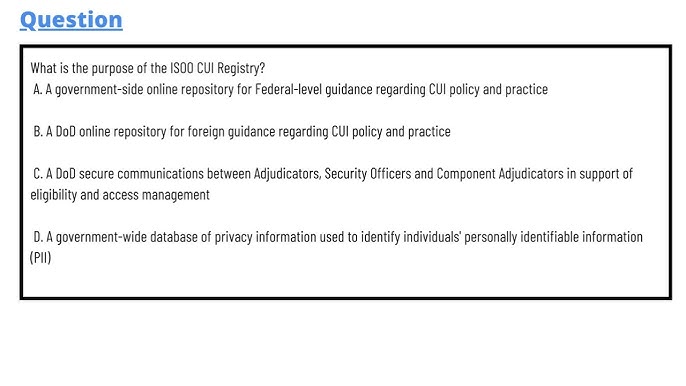Physical Address
304 North Cardinal St.
Dorchester Center, MA 02124
Physical Address
304 North Cardinal St.
Dorchester Center, MA 02124

Contents [hide]
The Information Security Oversight Office (ISOO) maintains the CUI registry to provide a standardized set of definitions and responsibilities for CUI across all government agencies and their contractors. The registry ensures that all entities handling CUI follow the same rules, with exceptions being minimal. For instance, the registry categorizes CUI into groups like Critical Infrastructure, which includes information such as chemical terrorism vulnerability and SAFETY Act data. All government bodies and contractors must mark and safeguard documents in these categories uniformly to avoid enforcement actions by ISOO or other regulatory bodies.
Additionally, there is a separate DoD CUI registry that mirrors the ISOO registry but includes additional rules specific to DoD personnel and contractors. This registry covers all CUI categories except Immigration, outlining distinct responsibilities and guidelines for DoD-related CUI handling.
DoD Instruction 5200.48 serves as the cornerstone of DoD’s directives on safeguarding CUI. It establishes the fundamental framework for the CUI program, outlining essential government departments that organizations must engage with for oversight and reporting purposes. The instruction details the core objectives and functions of CUI protection, specifying rules and examples for compliance.
One critical aspect outlined in DODI 5200.48 is the requirement for organizations to appropriately mark CUI with symbols or language indicating the type of information, authorized access, and controlling government entities. Ensuring accurate markings and controlling access as per stipulated guidelines is imperative. For instance, documents labeled “FEDCON” can be shared with federal employees and contractors, while “FED ONLY” files are restricted to employees only.
Besides DODI 5200.48, compliance with NIST Special Publication 800-171 is crucial for adhering to DoD’s CUI safeguarding directives. NIST SP 800-171 offers guidance on network security controls that organizations must implement to mitigate threats and vulnerabilities affecting CUI. The publication outlines 110 individual requirements across 14 families, covering aspects like access control, incident response, and risk assessment.
Adhering to NIST SP 800-171 is essential for complying with Defense Federal Acquisition Regulation Supplement (DFARS) requirements, which are applicable to most DoD entities and contractors. Implementing the controls specified in NIST SP 800-171 is vital for protecting CUI effectively.
While DODI 5200.48 and NIST SP 800-171 are key frameworks for CUI protection, compliance with the Cybersecurity Maturity Model Certification (CMMC) is also mandatory for DoD contractors. CMMC ensures that contractors possess the necessary capabilities to safeguard CUI and other sensitive data when working with the US military. Contractors are required to achieve a specific CMMC level based on their exposure to CUI:
Compliance with the appropriate CMMC level requirements is a crucial step towards aligning with DoD’s guidelines for safeguarding CUI effectively.
Maintaining a moderate level of system and network configuration is essential for protecting CUI effectively. Organizations handling CUI must ensure that their systems and networks meet the necessary security standards to safeguard sensitive information from unauthorized access or breaches.
Protecting Controlled Unclassified Information (CUI) in alignment with DoD guidelines necessitates a comprehensive understanding of the ISOO CUI registry, adherence to DoD Instruction 5200.48, implementation of NIST SP 800-171 controls, and compliance with the Cybersecurity Maturity Model Certification (CMMC). Organizations must prioritize CUI protection by following the prescribed frameworks and guidelines to mitigate risks and ensure data security. Seeking assistance from DoD compliance advisors like RSI Security can facilitate the process of meeting DoD compliance requirements and enhancing CUI protection measures.